Ice-age legacy may limit seagrasses’ capacity to withstand warming
(adapted from Smithsonian Environmental Research Center release)
Ancient migration, Pleistocene Ice Ages impact size & structure of modern eelgrass communities
Deep evolution casts a longer shadow than previously thought, scientists report in the August Proceedings of the National Academy of Sciences.
Researchers at the Smithsonian, William & Mary’s Virginia Institute of Marine Science (VIMS), and 28 other institutions worldwide looked at eelgrass communities—the foundation of many coastal marine food webs along the north Atlantic and Pacific coasts—and discovered their ancient genetic history can play a stronger role than present-day environments in determining growth form and community composition.
Crucially, lower genetic diversity in the Atlantic could make it hard for some U.S. East Coast eelgrass populations to adapt to threats like climate change.
The research adds to a wealth of findings that have emerged from an ecological monitoring network established by lead author Dr. Emmett Duffy before he departed VIMS in 2013 to direct the Smithsonian’s Tennenbaum Marine Observatories Network. Joining Duffy on the paper are VIMS emeritus professor Dr. Robert "JJ" Orth, Dive Safety Officer Paul Richardson, former post-doctoral researcher Dr. Pamela Reynolds, and former graduate students Drs. Jonathan Lefcheck and Matthew Whalen. The VIMS team provided eelgrass data from the Chesapeake Bay, one of 50 sites used in the global study.
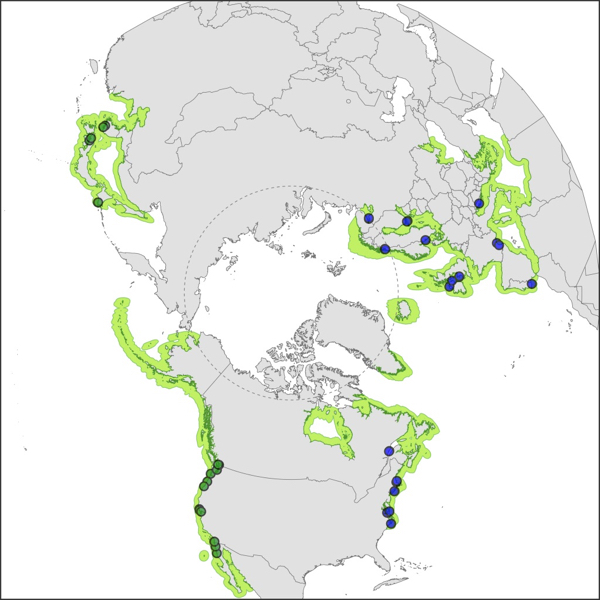 About a half-million years ago, when the world was warmer, a few cold-hardy eelgrass strains migrated from their homes in the Pacific along an ice-free Arctic shoreline to the Atlantic. Subsequent Pleistocene ice ages then acted to isolate the migrant populations. These millennia-old struggles left lasting signatures in their DNA: Even today, eelgrass populations in the Atlantic are far less genetically diverse than those in the Pacific.
About a half-million years ago, when the world was warmer, a few cold-hardy eelgrass strains migrated from their homes in the Pacific along an ice-free Arctic shoreline to the Atlantic. Subsequent Pleistocene ice ages then acted to isolate the migrant populations. These millennia-old struggles left lasting signatures in their DNA: Even today, eelgrass populations in the Atlantic are far less genetically diverse than those in the Pacific.
Still, in the classic “nature versus nurture” debate, the researchers were stunned to discover that genetic legacy may shape modern eelgrass communities more than the current environment. Their observations and modeling show that while Pacific eelgrasses often grow in “forests” that regularly surpass 3 feet, the Atlantic—even under similar temperature, salinity, and nutrient levels—hosts more diminutive “meadows.” The genetic differences also align with the biomass of eelgrass and its associated invertebrate communities.
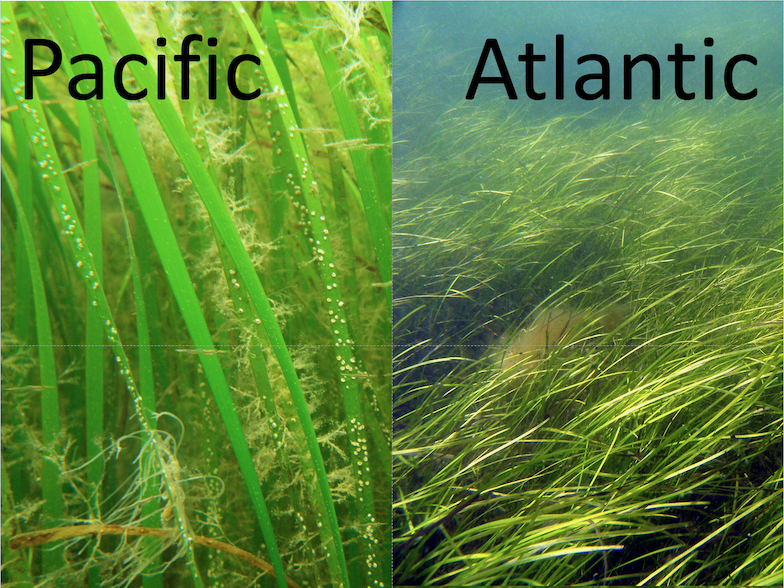
“We already knew that there was big genetic separation between the oceans, but I don’t think any of us ever dreamed that that would be more important than environmental conditions,” says Duffy. “That was a big surprise to everybody.”
Eelgrasses in hot water
That ancient genetics can play such a strong role—sometimes stronger than the environment—has many ecologists concerned about whether eelgrass can adapt to more rapid changes such as human-induced climate warming. The concern is greatest in the Atlantic, where the plant’s lower genetic diversity could make it hard for some populations to adapt to sudden changes.
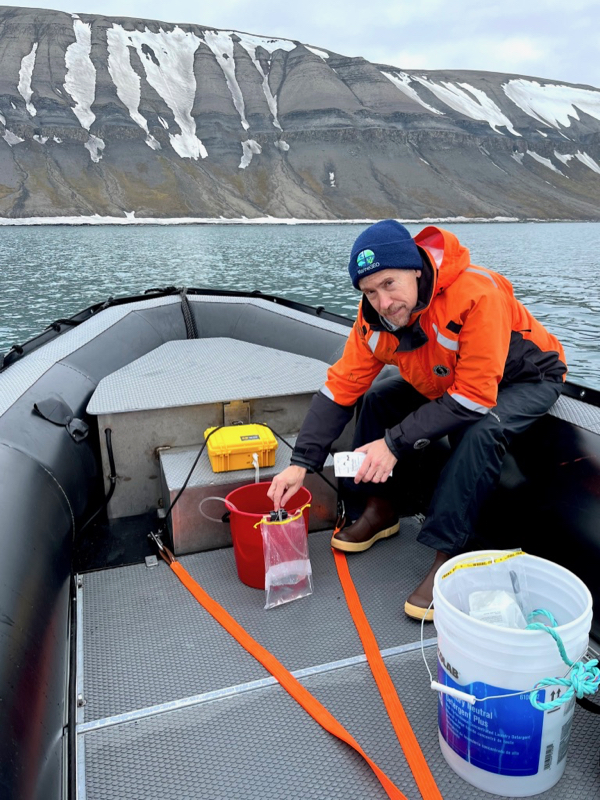
“Diversity is like having different tools in your tool belt,” says Jay Stachowicz, a co-author and ecologist with the University of California, Davis. “And if all you’ve got is a hammer, you can put in nails, but that’s about it. But if you have a full complement of tools, each tool can be used to do different jobs more efficiently.”
Orth, who founded VIMS’ Seagrass Monitoring and Restoration program and directed it for more than 40 years before retiring in 2021, says “The Chesapeake Bay data are very important, as the Bay is near the southernmost range for eelgrass along the Atlantic coast. 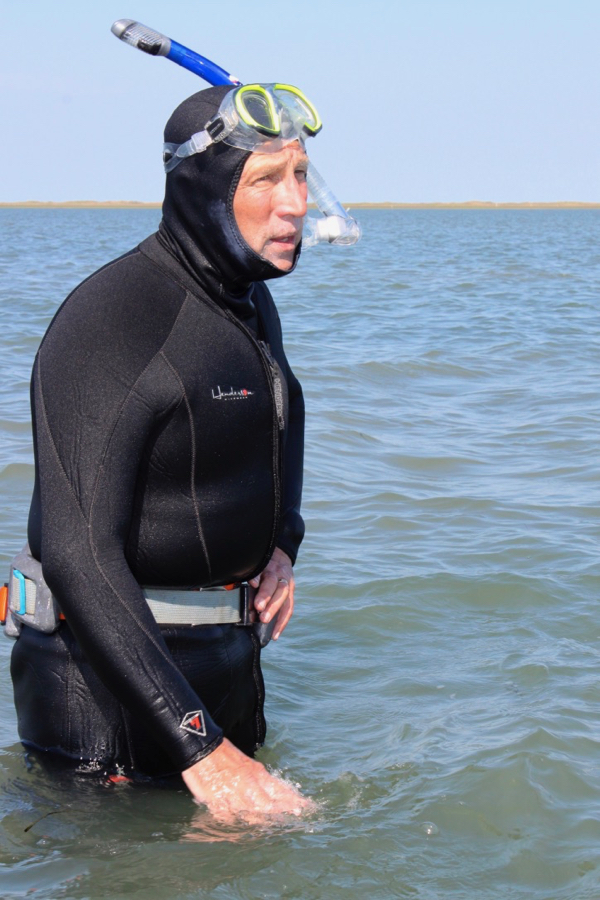 Understanding these evolutionary considerations is really important for eelgrass in the Chesapeake, as it will be most susceptible to the warming ocean temperatures associated with a changing climate.”
Understanding these evolutionary considerations is really important for eelgrass in the Chesapeake, as it will be most susceptible to the warming ocean temperatures associated with a changing climate.”
Dr. Christopher Patrick, current director of the seagrass program at VIMS, agrees. “This work is important,” he says, “because it demonstrates something we’ve long suspected, that the plasticity and adaptability of eelgrass in the Atlantic Basin, relative to eelgrass worldwide, is constrained by its genetic history. This has important implications for understanding how eelgrass in the Chesapeake Bay will respond to climate change.”
Ecologists have already seen eelgrass disappearing from some regions as the waters heat up. A 2017 VIMS study attributed long-term eelgrass loss In the Chesapeake Bay to the joint effects of shade and heat. In Portugal, its southernmost spot in Europe, eelgrass has begun pulling back and moving farther north, into cooler waters.
Conserving the future
To protect existing eelgrass beds, maintaining current diversity is a good first step. In places that have already lost eelgrass beds, restoration offers some promise. Some success stories already exist, such as the VIMS-led efforts in the seaside bays of Virginia’s Eastern Shore. But many restoration efforts achieve only limited success.
Stachowicz says this raises additional questions. “Should you be restoring seagrass using plants from local environments, or should you be thinking to the future and trying plants with genetics better suited to future environmental conditions?” he asks. “Or should you hedge your bets?” Maintaining or enhancing genetic diversity could be the best way to provide populations of seagrass with the diverse toolkit needed to survive in an uncertain future.
Patrick, who was not involved in the current study, has begun to contemplate those same questions. “From a conservation and restoration perspective,” he says, the study “supports the idea that we might begin to explore whether enhancing Atlantic populations with Pacific brood stock might increase the overall resilience of Atlantic eelgrass to climate change.”
“I don’t think we’re going to lose [eelgrass] in the sense of a [global] extinction,” says co-author Jeanine Olsen, an emeritus professor at the University of Groningen in the Netherlands. “It’s not going to be like that. It’s got lots of tricks up its sleeve.” But local extinctions, she pointed out, are going to occur in some places. That could leave regions like Chesapeake Bay that depend on their local eelgrass in trouble.
“Climate warming—by itself—is probably not the primary threat for eelgrass,” Olsen says. Pollution from cities and farms, which can cloud the water and lead to harmful algal blooms, also endangers seagrasses. That said, the vast array of environments eelgrass can survive in testifies to its hardiness.
“I’m hopeful because our results illustrate long-term resiliency to repeated, major changes in thermal tolerances and the wide range of eelgrass habitats over about half the Northern Hemisphere,” Olsen says. “With the genomic resources now available for eelgrass, we are beginning to analyze functional changes in genes and their regulation in real time. It’s very exciting.”
Reaching a More ZEN Worldview
The study is one of the many research products generated by the Zostera Experimental Network, or ZEN, a nod to eelgrass’s scientific name Zostera marina. Duffy and colleagues banded together to form ZEN in 2011, realizing the urgent need to understand—and conserve—eelgrass worldwide. The idea was to unite seagrass scientists all over the world, doing the same experiments and surveys, to get a coordinated global picture of seagrass health.
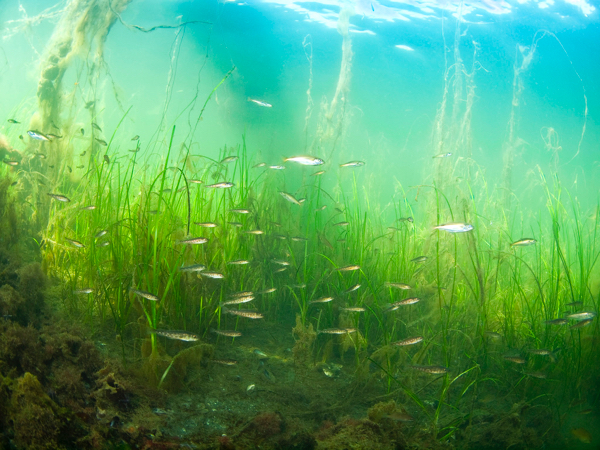 For the new study, the team studied eelgrass communities at 50 sites in the Atlantic and Pacific. With 20 plots sampled per site, the team came away with data from 1,000 eelgrass plots.
For the new study, the team studied eelgrass communities at 50 sites in the Atlantic and Pacific. With 20 plots sampled per site, the team came away with data from 1,000 eelgrass plots.
First they collected basic eelgrass data: size, shape, total biomass, and the different animals and algae living on and around them. Then they collected genetic data on all the eelgrass populations. They also measured several environmental variables at each site: temperature, the water’s saltiness , and nutrient availability, to name just a few.
Ultimately, they hoped to discover what shaped eelgrass communities more: the environment or the genetics?
After running a series of models, they discovered a host of differences between the Atlantic and Pacific eelgrass ecosystems—differences that closely aligned with genetic divergence due to the Pleistocene migration and subsequent ice ages.
While Pacific eelgrasses often grew in “forests” that regularly surpassed 3-feet tall and sometimes reached more than twice that high, the Atlantic hosted more diminutive “meadows” that rarely came close to that height. The genetic differences also aligned with the total biomass of eelgrass. In the Atlantic, evolutionary genetics and the present-day environment played equally strong roles in eelgrass biomass. In the Pacific, genetics had the upper hand.
These impacts flowed up to other parts of the ecosystem as well. When it came to small animals that lived in the eelgrass, such as invertebrates, the genetic signature from the Pleistocene played a weaker role than the environment in the Pacific—while the two played equally strong roles in the Atlantic.
“The ancient legacy of this Pleistocene migration and bottleneck of eelgrass into the Atlantic has had consequences for the structure of the ecosystem 10,000 years later,” Duffy says. “Probably more than 10,000.”
| Duffy, J.E., Stachowicz, J.J., Reynolds, P.L., et al. 2022. A Pleistocene legacy structures variation in modern seagrass ecosystems. Proceedings of the National Academy of Sciences of the United States of America. https://doi.org/10.1073/pnas.2121425119. |
